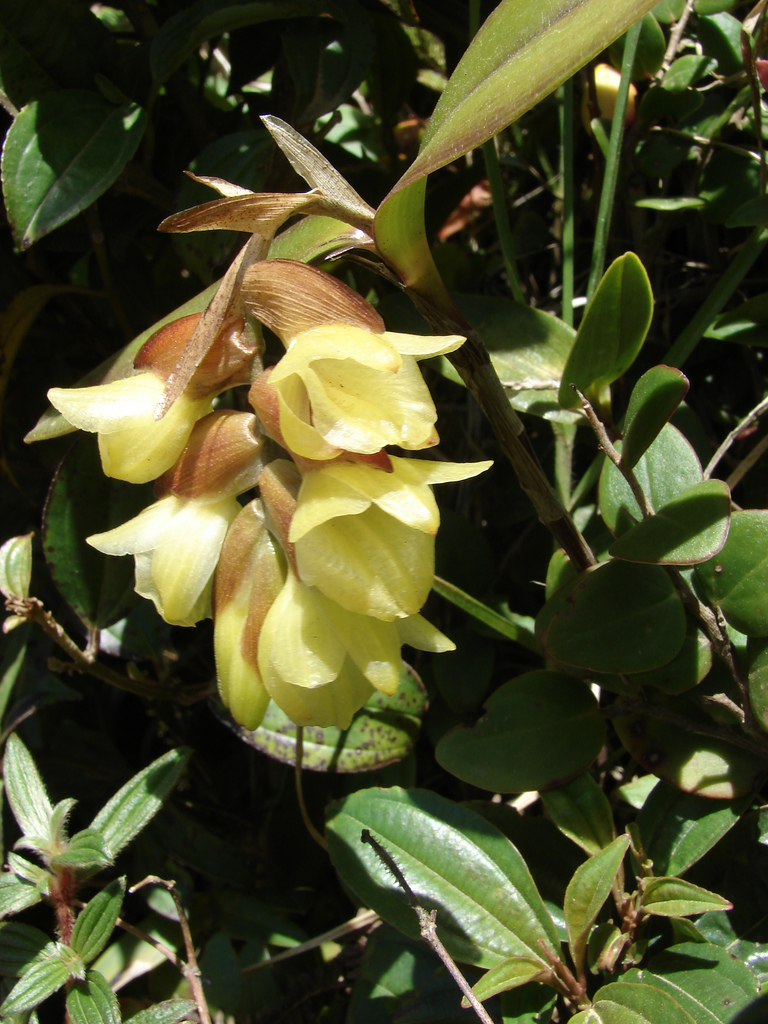

Epidendrum polychlamys Schltr. 1906 GROUP Polychlamys SUBGROUP PolychlamysTYPE for the group
Photo by I Rojas ©
Drawing by © Jimenez, Hágsater & E.Santiago and The AMO Herbario Website








Common Name The Many Mantled Epidendrum [refers to the prominent floral bracts which embrace the ovary and half of the flower]
Flower Size 2.4" [6 cm]
Found in Costa Rica and Panama at elevations between 1100 to 2500 meters as a medium sized, cool to cold growing epiphyte or terrestrial on roadside banks near the top ridge of the cordillera with simple, thin, terete, arching, cane-like stems arising from the middle of the previous cane and enveloped by tubular, scarious, acute sheaths becoming fibrous with age and carrying 1 to 3, clustered towards the apex, alternate, articulate, elliptic, spreading, subacute, coriaceous, entire margined leaves that blooms at most any time of the year on a terminal, occuring only once, racemose, distichous, arching-nutant, densely, successively 5 to 15 flowered inflorescence enveloped completely by 2, ovate, acute, conduplicate, ancipitous bracts and has twice as long as the ovary, also covering half the flower, apically progressively shorter, ovate, acute, conduplicate, ancipitous, spreading floral bracts carrying distichous, resupinate, fragrant, yellow, rarely pink colored flowers.
Recognized by the rhizomatous plant with the roots arising from the basal nodes of the stem, carrying 2 to 3, elliptic leaves towards the apex of the stem, a very short inflorescence with narrowly ovate floral bracts that are longer than the ovary and a narrowly oblong, apiculate lip.
"Epidendrum polychlamys belongs to the GROUP Polychlamys SUBGROUP Polychlamys which is characterized by the scandent habit due to the successive lateral growths produced from the middle of the previous growth, few leaves aggregate towards the apex of the stems, the distichous, apical inflorescence with prominent, conduplicate, acute, grumaceous floral bracts. The species is distinguished by the medium to large showy flowers, sepals partly spreading, .6 to 1.12" [15 to 28 mm] long yellowish green to rarely cinnamon-pink, the petals widely obranceolate .28 to .36" [7 to 9 mm] wide; the ovary not forming a vesicle, and the lip obovate or widely oblong, with a central fleshy keel which reaches the apex of the lip. Epidendrum atwoodchlamys Hagsater has large yellow to greenish yellow flowers, wlth the lateral sepals connate at the base, .72 to .96" [18 to 24 mm] long, the petals widely obovate, .4 to .5" [10 to 12.5 mm] wide, a suborbicuiar lip with the base cordate, and the ovary does not form a vesicle. Epldendrum estrellense Ames has smaller, greenish yellow to green flowers, the sepals .26 to .4" [6.5 to 10 mm] long, the lip suborbicular, cordate, with 3 thin keels; the ovary does not form a vesicle. Epidendrum dolichoclamys Hágsater & E.Santiago has an elongate flexuous inflorescence, with large drooping floral bracts, showy flowers, the sepals .8 to .88" [20 to 22 mm] long, green tinged wine-red to purple, and the nectary forming a prominent vesicle along the apical half of the ovary.
Synonyms
References W3 Tropicos, Kew Monocot list , IPNI ; Repert. Sp. Nov. Regni. Veg. Beih. 19: 43. Costa Rica Schlechter 1923; The Genus Epidendrum Ames 1936; Ceiba Vol 5 No 1 L O Williams 1956; AOS Bulletin Vol 31 No 3 1962 photo fide; Icones Planetarum Tropicarum Plate 1325 Atwood 1992 drawing ok; Field Guide to the Orchids of Costa Rica and Panama Dressler 1993; Icones Orchidacearum 2 Plate 115 Hagsater & Sanchez 1993 see recognition section; Icones Orchidacearum 2 Plate 154 Hagsater & Dodson 1993 see recognition section; Icones Orchidacearum 3 Plate 310 Hagsater 1999 see recogntion section; Icones Orchidacearum 3 Plate 381 Hagsater 1999 see recognition section; Manual de las Plantas de Costa Rica Vol 3 Hammel, Grayum, Herrera and Zamora 2003; Vanishing Beauty, Native Costa Rican Orchids Vol 1 Pupulin 2005 photo fide; Icones Orchidacearum Vol 8 Plate 829 Hagsater & Sanchez 2006 see recognition section; Icones Orchidacearum 8 Plate 883 Hagsater 2007 see recognition section; ; Icones Orchidacearum Vol 9 Plate 911 Hagsater & Sanchez 2007 see recognition section; Icones Orchidacearum 9 Plate 976 Hagsater 2007 drawing fide; Lankesteriana 19(1). 31 - 55 2019 photo fide
--------------------------------------------------------------------------------------------------------------------------